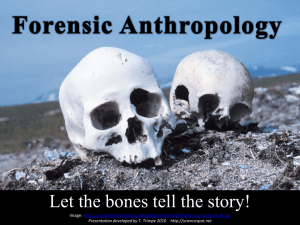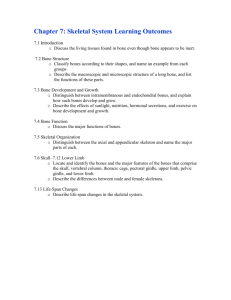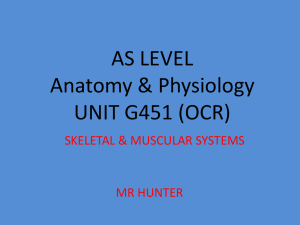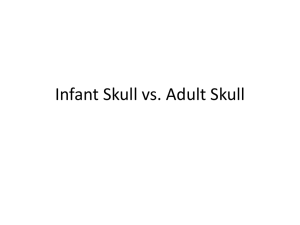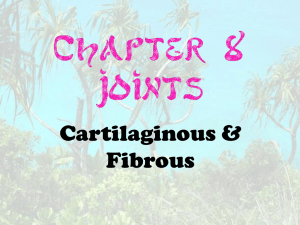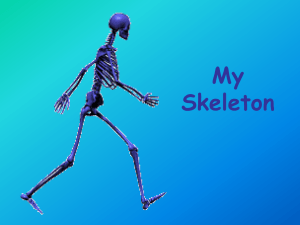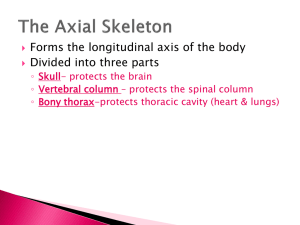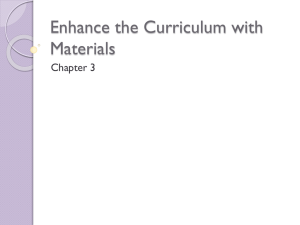The Skeleton: Skull
advertisement
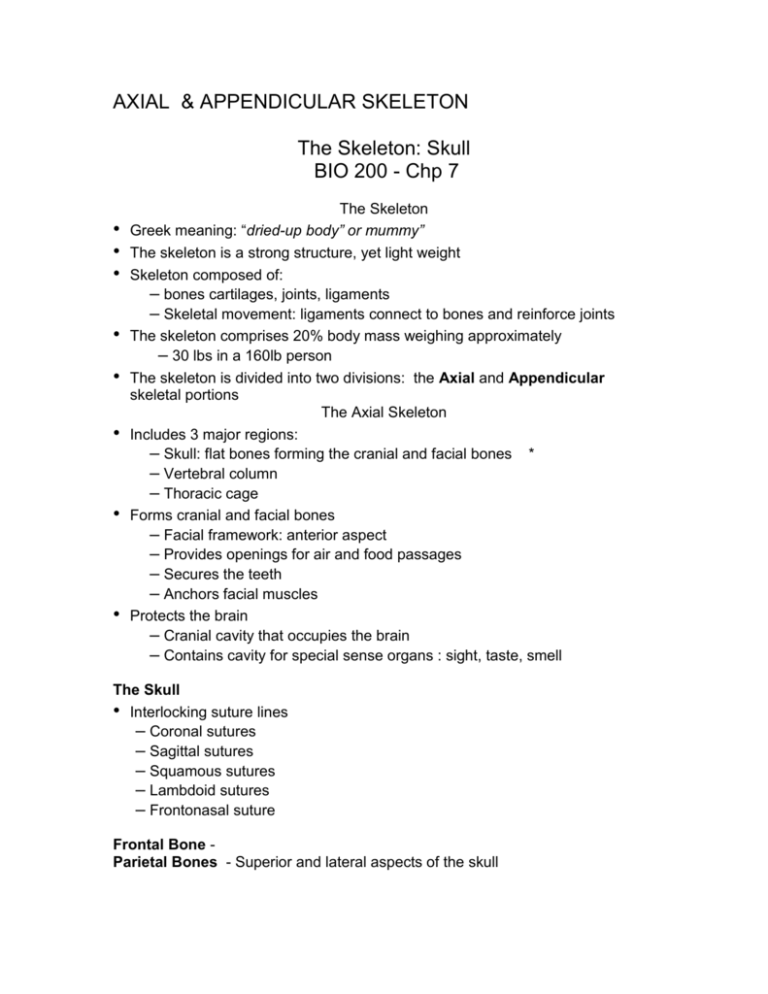
AXIAL & APPENDICULAR SKELETON The Skeleton: Skull BIO 200 - Chp 7 • • • • • • • • The Skeleton Greek meaning: “dried-up body” or mummy” The skeleton is a strong structure, yet light weight Skeleton composed of: – bones cartilages, joints, ligaments – Skeletal movement: ligaments connect to bones and reinforce joints The skeleton comprises 20% body mass weighing approximately – 30 lbs in a 160lb person The skeleton is divided into two divisions: the Axial and Appendicular skeletal portions The Axial Skeleton Includes 3 major regions: – Skull: flat bones forming the cranial and facial bones * – Vertebral column – Thoracic cage Forms cranial and facial bones – Facial framework: anterior aspect – Provides openings for air and food passages – Secures the teeth – Anchors facial muscles Protects the brain – Cranial cavity that occupies the brain – Contains cavity for special sense organs : sight, taste, smell The Skull • Interlocking suture lines – Coronal sutures – Sagittal sutures – Squamous sutures – Lambdoid sutures – Frontonasal suture Frontal Bone Parietal Bones - Superior and lateral aspects of the skull Occipital Bone and Its Major Markings • Forms posterior wall and base • Major markings: posterior cranial fossa, foramen magnum, occipital condyles, and the hypoglossal canal The Skull forms a Cranial vault (Calvaria or bald skull) – Superior, lateral and posterior aspects – Include the forehead – Cranial base (floor) – Inferior aspect – 3 prominent internal ridges: • Anterior fossae • Middle fossae • Posterior fossae Inferior Portion of Skull Other Smaller Cavities located in the skull include: – Middle and internal ear cavities – Nasal cavity – Orbits Air-filled sinuses: Frontal sinuses, sphenoid sinuses, ethmoid sinuses and the maxillary sinuses. Small cavity openings that include: Foramina, Canals, and fissures Temporal Bones • Form the inferolateral aspects of the skull and parts of the cranial floor • Divided into 4 major regions – squamous, tympanic, mastoid, and petrous • Major markings: zygomatic, styloid, and mastoid processes, and the mandibular and middle cranial fossae • Major openings include the stylomastoid and jugular foramina, the external and internal auditory meatuses, and the carotid canal Sphenoid Bone • Butterfly-shaped bone, width of the middle cranial fossa • Forms central wedge that articulates with all other cranial bones • Consists of a central body, greater wings, lesser wings, and pterygoid processes • Major markings: the sella turcica, hypophyseal fossa, and the pterygoid processes • Major openings include the foramina rotundum, ovale, and spinosum; the optic canals; and the superior orbital fissure Ethmoid Bone • Most deep of the skull bones; lies between the sphenoid and nasal bones • Forms most of the bony area between the nasal cavity and the orbits • Major markings include the cribriform plate, crista galli, perpendicular plate, nasal conchae, and the ethmoid sinuses Facial Bones • Fourteen bones of which only the mandible and vomer are unpaired • The paired bones are the maxillae, zygomatics, nasals, lacrimals, palatines, and inferior conchae Mandible and Its Markings • The mandible (lower jawbone) – largest, strongest bone of the face • Its major markings include the coronoid process, mandibular condyle, the alveolar margin, and the mandibular and mental foramina Maxillary Bones • Upper jaw and the central portion of the facial skeleton • Facial keystone bones that articulate with all other facial bones except the mandible • Major markings include palatine, frontal, and zygomatic processes, the alveolar margins, inferior orbital fissure, and the maxillary sinuses Zygomatic Bones • Irregularly shaped bones (cheekbones) that form the prominences of the cheeks and the inferolateral margins of the orbits Wormian Bones • Tiny irregularly shaped bones that appear within sutures Other Facial Bones • Nasal bones – thin medially fused bones that form the bridge of the nose • Lacrimal bones – contribute to the medial walls of the orbit and contain a deep groove called the lacrimal fossa that houses the lacrimal sac • Palatine bones – two bone plates forming the hard palate, the posterolateral walls of the nasal cavity, and a small part of the orbits • Vomer – plow-shaped bone that forms part of the nasal septum • Inferior nasal conchae – paired, curved bones in the nasal cavity that form part of the lateral walls of the nasal cavity • Orbits - bony cavities in which the eyes are firmly encased and cushioned by fatty tissue • Nasal Cavity - bone and hyaline cartilage • Paranasal Sinuses - Mucosa-lined, air-filled sacs. – Air enters the paranasal sinuses from the nasal cavity and mucus drains into the nasal cavity from the sinuses – Lighten the skull and enhance the resonance of the voice Hyoid Bone • Not actually part of the skull, but lies just inferior to the mandible in the anterior neck • Only bone of the body that does not articulate directly with another bone • Attaches neck muscles that raise and lower the larynx during swallowing and speech The Skeleton: Vertebral Column BIO 200 - Chp 7 Formed from 26 irregular bones (vertebrae) connected in such a way that a flexible curved structure results – Cervical vertebrae – 7 bones of the neck – Thoracic vertebrae – 12 bones of the torso – Lumbar vertebrae – 5 bones of the lower back – Sacrum – bone inferior to the lumbar vertebrae that articulates with the hip bones Vertebral Column: Curvatures • Posteriorly concave curvatures – cervical and lumbar • Posteriorly convex curvatures – thoracic and sacral • Abnormal spine curvatures include scoliosis (abnormal lateral curve), kyphosis (hunchback), and lordosis (swayback) Vertebral Column: Ligaments • Anterior and posterior longitudinal ligaments – continuous bands down the front and back of the spine from the neck to the sacrum • Short ligaments connect adjoining vertebrae together Vertebral Column: Intervertebral Discs • Cushion-like pad composed of two parts – Nucleus pulposus – inner gelatinous nucleus that gives the disc its elasticity and compressibility – Annulus fibrosus – surrounds the nucleus pulposus with a collar composed of collagen and fibrocartilage Intervertebral Discs - General Structure of Vertebrae • Spinous processes project posteriorly, and transverse processes project laterally • Superior and inferior articular processes – protrude superiorly and inferiorly from the pedicle-lamina junctions • Intervertebral foramina – lateral openings formed from notched areas on the superior and inferior borders of adjacent pedicles Cervical Vertebrae • Seven vertebrae (C1-C7) are the smallest, lightest vertebrae • C3-C7 are distinguished with an oval body, short spinous processes, and large, triangular vertebral foramina • Each transverse process contains a transverse foramen Cervical Vertebrae: The Atlas (C1) • The atlas has no body and no spinous process • It consists of anterior and posterior arches, and two lateral masses • The superior surfaces of lateral masses articulate with the occipital condyles Cervical Vertebrae: The Axis (C2) • The axis has a body, spine, and vertebral arches as do other cervical vertebrae • Unique to the axis is the dens, or odontoid process, which projects superiorly from the body and is cradled in the anterior arch of the atlas • The dens is a pivot for the rotation of the atlas Thoracic Vertebrae • There are twelve vertebrae (T1-T12) all of which articulate with ribs • Major markings include two facets and two demifacets on the heart-shaped body, the circular vertebral foramen, transverse processes, and a long spinous process • The location of the articulate facets prevents flexion and extension, but allows rotation of this area of the spine Lumbar Vertebrae • The five lumbar vertebrae (L1-L5) are located in the small of the back and have an enhanced weight-bearing function • They have short, thick pedicles and laminae, flat hatchet-shaped spinous processes, and a triangular-shaped vertebral foramen • Orientation of articular facets locks the lumbar vertebrae together to provide stability Sacrum – Consists of 5 fused vertebrae (S1-S5), – They shape the posterior wall of the pelvis – Articulates with L5 superiorly, and with the auricular surfaces of the hip bones – Major markings: sacral promontory, transverse lines, alae, dorsal sacral foramina, sacral canal, and sacral hiatus Coccyx - (Tailbone) – The coccyx is made up of four (in some cases three to five) fused vertebrae that articulate superiorly with the sacrum Sacrum and Coccyx • Anterior View (see text book) • Posterior View Bony Thorax (Thoracic Cage) • thoracic vertebrae (dorsally) • the ribs (laterally) • sternum • costal cartilages (anteriorly) • Functions – Forms a protective cage around the heart, lungs, and great blood vessels – Supports the shoulder girdles and upper limbs – Provides attachment for neck, back, chest, and shoulder muscles – Uses intercostal muscles to lift and depress thorax during breathing Sternum (Breastbone) • A dagger-shaped, flat bone that lies anterior midline • 3 fused bones – the superior manubrium, the body, and the inferior xiphoid process • Anatomical landmarks: jugular notch (suprasternal), the sternal angle, and the xiphisternal joint Ribs • 12 pair forming the flaring sides of the thoracic cage • All ribs are posteriorly attached to the thoracic vertebrae • The superior 7 pair (true, or vertebrosternal ribs) attach directly to the sternum via costal cartilages • Ribs 8-10 (false, or vertebrocondral ribs) attach indirectly to the sternum via costal cartilage • Ribs 11-12 (floating, or vertebral ribs) have no anterior attachment Typical True Rib – is Bowed, flat bone consisting of a head, neck, tubercle, and shaft Appendicular Skeleton • The appendicular skeleton is made up of the bones of the limbs and their girdles • Pectoral girdles attach the upper limbs to the body trunk • Pelvic girdle secures the lower limbs Pectoral Girdles (Shoulder Girdles) • Consist of the anterior clavicles and posterior scapulae • They attach the upper limbs to the axial skeleton allowing for maximum movement • They provide attachment points for muscles that move the upper limbs Clavicles (Collarbones) • Slender, doubly curved long bones lying across the superior thorax • The acromial (lateral) end articulates with the scapula • The sternal (medial) end articulates with the sternum • Provide attachment points for muscles • Braces the scapulae and arms laterally away from the body Scapulae (Shoulder Blades) • Triangular, flat bones lying on the dorsal surface of the rib cage, between the 7th and 8th ribs • Scapulae have 3 borders and 3 angles • Major markings: suprascapular notch, the supraspinous and infraspinous fossae, the spine, the acromion, and the coracoid process The Skeleton: Apendicular BIO 200 – Chp 7 The Upper Limb • The upper limb consists of the arm (brachium), forearm (antebrachium), and hand (manus) • Thirty-seven bones form the skeletal framework of each upper limb The Arm - Humerus Bone • The sole bone of the arm • Articulates with the scapula at the shoulder, and the radius and ulna at the elbow Arm • Major markings – Proximal humerus: the head, anatomical and surgical necks, greater and lesser tubercles, and the intertubercular groove – Distal humerus - capitulum, trochlea, medial and lateral epicondyles, and the coronoid and olecranon fossae – Medial portion includes the radial groove and the deltoid process Bones of the Forearm Forearm • The bones of the forearm are the radius and ulna • They articulate proximally with the humerus and distally with the wrist bones • They also articulate with each other proximally and distally at small radioulnar joints Ulna (elbow) • The ulna lies medially in the forearm and is slightly longer than the radius • Forms the major portion of the elbow joint with the humerus • Its major markings: the olecranon, coronoid process, trochlear notch, radial notch, and the styloid process Radius (rod) • The radius lies opposite (lateral to) the ulna • It’s thin at its proximal end, widened distally • The superior head articulates with the capitulum of the humerus • Medially, the head articulates with the radial notch of the ulna • Major markings: radial tuberosity, ulnar notch, and styloid process • Most commonly Fx when breaking a fall Hand Skeleton • Carpals - wrist bones • Metacarpals - palm bones • Phalanges - fingers bones Carpus (Wrist) – Scaphoid – Lunate – Triquetral – Pisiform proximally – Trapezium – Trapezoid – Capitate – Hamate distally Metacarpus (Palm) • Five numbered (1-5) metacarpal bones • Radiate from the wrist to form the palm – Their bases articulate with the carpals proximally, and with each other medially and laterally – Heads articulate with the phalanges Phalanges (Fingers) • Each hand contains 14 miniature long bones called phalanges • Fingers (digits) are numbered 1-5, beginning with the thumb (pollex) • Each finger (except the thumb) has three phalanges – distal, middle, and proximal • The thumb has no middle phalanx Pelvic Girdle (Hip) • The hip is formed by a pair of hip bones • (os coxae, or coxal) • Together with the sacrum and the coccyx, these bones form the bony pelvis • Attaches the lower limbs to the axial skeleton • Transmits upper body wt. to the lower limbs • Supports the visceral organs of the pelvis • The ilium is a flaring large bone that forms the superior region of the coxal bone • It consists of a body and a superior wing-like portion called the ala • The broad posterolateral surface is called the gluteal surface • Articulates with the sacrum (sacroiliac joint) • Major markings: iliac crests, four spines, greater sciatic notch, iliac fossa, arcuate line, pelvic brim Comparison of Male & Female Pelvic Structure • Female pelvis – Tilted forward, adapted for childbearing – True pelvis defines birth canal – Cavity of the true pelvis is broad, shallow, and has greater capacity • Male pelvis – Tilted less forward – Adapted for support of heavier male build and stronger muscles – Cavity of true pelvis is narrow and deep Ischium • The ischium forms the posteroinferior part of the hip bone • Articulates with the ilium, and the thinner ramus articulates with the pubis • Major markings: ischial spine, lesser sciatic notch, and the ischial tuberosity Pubis • The pubic bone forms the anterior portion of the hip bone • It articulates with the ischium and the ilium • Major markings: the superior and inferior rami, the pubic crest, pubic tubercle, pubic arch, pubic symphysis, and obturator foramen (along with ilium and ischium) The Lower Limb • 3 segments: thigh, leg, and foot • They carry the weight of the erect body • Subjected to exceptional forces when jumping or running Femur (leg) • The only thigh bone is the femur, the largest and strongest bone in the body • It articulates proximally with the hip and distally with the tibia and fibula • Major markings: fovea capitis, greater and lesser trochanters, gluteal tuberosity, lateral and medial condyles and epicondyles, linea aspera, patellar surface, and the intercondylar notch Femur • The tibia and fibula form the skeleton of the leg • They are connected to each other by the interosseous membrane • They articulate with the femur proximally and with the ankle bones distally • They also articulate with each other via the immovable tibiofibular joints Tibia • Receives the weight of the body from the femur and transmits it to the foot • Major markings include medial and lateral condyles, intercondylar eminence, the tibial tuberosity, anterior crest, medial malleolus, and fibular notch Fibula • Sticklike bone with slightly expanded ends located laterally to the tibia • Major markings: head and lateral malleolus Tibia and Fibula Foot • Foot skeleton - tarsus, metatarsus, phalanges (toes) • The foot supports body weight and acts as a lever to propel the body forward in walking and running Tarsus • Composed of seven bones that form the posterior half of the foot • Body weight is carried primarily on the talus and calcaneus • Talus articulates with the tibia and fibula superiorly, and the calcaneus inferiorly • Other tarsus bones include the cuboid and navicular, and the medial, intermediate, and lateral cuneiforms Calcaneus • Forms the heel of the foot • Carries the talus on its superior surface • Point of attachment for the calcaneal (Achilles) tendon of the calf muscles Metatarsus and Phalanges • Metatarsals – Five (1-5) long bones that articulate with the proximal phalanges – The enlarged head of metatarsal 1 forms the “ball of the foot” • Phalanges – The 14 bones of the toes – Each digit has three phalanges except the hallux, which has no middle phalanx Metatarsus and Phalanges - Arches of the Foot • The foot has three arches maintained by interlocking foot bones and strong ligaments - springiness • Arches allow the foot to hold up weight • The arches are: – Lateral longitudinal – cuboid is keystone of this arch – Medial longitudinal – talus is keystone of this arch – Transverse – runs obliquely from one side of the foot to the other Developmental Aspects: Fetal Skull • Infant skull has more bones than the adult skull • At birth, fetal skull bones are incomplete and connected by fontanels • Fontanels – Unossified remnants of fibrous membranes between fetal skull bones – The four fontanels are anterior, posterior, mastoid, and sphenoid Developmental Aspects: Fetal Skull • Skull bones such as the mandible and maxilla are unfused Developmental Aspects: Growth Rates • At birth, the cranium is relatively huge to the face • Mandible and maxilla are foreshortened but lengthen with age • The arms and legs grow at a faster rate than the head and trunk, leading to adult proportions Developmental Aspects: Spinal Curvature • Only thoracic and sacral curvatures are present at birth • The primary curvatures are convex posteriorly, causing the infant spine to arch like a four-legged animal • Secondary curvatures – cervical and lumbar – are convex anteriorly and are associated with the child’s development Developmental Aspects: Old Age • Intervertebral discs become thin, less hydrated, and less elastic • Risk of disc herniation increases • Loss of stature by several centimeters is common after age 55 • Costal cartilages ossify causing the thorax to become rigid • All bones lose mass
